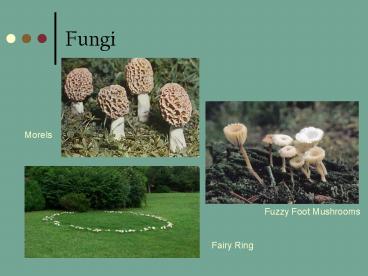Fungi - PowerPoint PPT Presentation
1 / 21
Title:
Fungi
Description:
This is the phylum that includes mushrooms. ... can tell the difference between poisonous and non-poisonous mushrooms ... We can eat some types of mushrooms. ... – PowerPoint PPT presentation
Number of Views:580
Avg rating:3.0/5.0
Title: Fungi
1
Fungi
Morels
Fuzzy Foot Mushrooms
Fairy Ring
2
What are they?
- Eukaryotic
- Heterotrophs (decomposers or parasites)
- Cell walls of chitin, a complex carbohydrate.
- Multicellular except yeasts are unicellular
- Fungi have been around for 450-500 million years.
3
What are they?
- Lack of chlorophyll affects the lifestyle of
fungi - Not dependent on light
- Can occupy dark habitats
- Can grow in any direction
- Can invade the interior of a substance with
absorptive filaments
4
If its a heterotroph and it cant hunt, how does
it get its energy?
- Many fungi are saprobes, so they feed on dead and
decaying matter. - Others are parasitic.
- And a few are carnivorous.
- All must digest food outside of their bodies and
then absorb the nutrients.
5
Fungal Nutrition
- As heterotrophs, fungi obtain nutrition by
absorption. - Digestive enzymes secreted by the fungus
breakdown complex food molecules outside of the
fungal body - These smaller molecules are absorbed by diffusion
6
Fungal Structure Hyphae
- Fungi are composed of tiny, tubular threadlike
structures called hyphae (hypha) - Hyphae form an interwoven mat called a mycelium
(mylcelia). This is the feeding network of a
fungus. - Mycelium maximize contact with the food source,
thereby maximizing absorption - Hyphae are divided by crosswalls with a pore
allowing cytoplasm to flow from cell to cell.
7
Fungal Nutrition
- Heterotrophic by absorption animation
- video of hyphal growth
8
They can be.
- Tiny, like yeast (the yeast here are magnified)
- Or really, really big like a Amillaria bulbosa.
One in Michigan was found to be bigger than 33
footballs fields!!
9
Fungal Reproduction
- Fungi reproduce by releasing spores that are
produced by either sexually or asexually. - Easily carried by wind or water, spores germinate
to produce mycelia if they land in a moist place
where there is food
10
The Kingdom of Fungi
- The kingdom is divided up by the structure of the
fungi and the way they reproduce. Most reproduce
sexually and asexually. - The 4 phyla that we will be looking at are
- Zygomycota- the common molds
- Ascomycota- the sac fungi
- Basidiomycota- the club fungi
- Deuteromycota- the imperfect fungi
11
Phylum Zygomycota
- The common molds are the ones that appear on
bread and cheese. - The part of the mold you see is the stolons. The
parts that penetrate the bread are the rhizoids. - Their spores are produced in zygosporangia
12
Phylum Ascomycota Sac Fungi
- This is the largest phylum in the kingdom.
- Spores are held in structures called an ascus
- Yeasts are found in very moist environments and
are used for making bread and beer. They are
also the pink coating that can appear on shower
curtains.
13
Phylum Basidiomycota
- This is the phylum that includes mushrooms.
- This phylum has the most complex life cycle of
any fungi. - Only an expert can tell the difference between
poisonous and non-poisonous mushrooms - Spores produced and held by basidia
14
These are all members of Basidiomycotes
Orange Jelly Fungus
Birds Nest Fungus
Star Stinkhorn Fungus
Puffball
Puffball
15
Phylum Deuteromycotes
- These are the imperfect fungi, but there is
nothing wrong with them. - They are called imperfect because researchers
have never observed a sexual phase in their life
cycle. - The genera Penicillium is the source of the
antibiotic penicillin
16
The good side of fungi
- They can be major decomposers of dead stuff.
- We can eat some types of mushrooms.
- Fungus is used to make some cheeses, medicines
and most breads. - The first antibiotic discovered was penicillin,
which is made by a common mold.
17
And the bad side
- They can cause diseases in plants.
- On the left is an ear of corn with corn smut,
caused by a fungus. - On the right, is a wheat plant with rust, also
caused by a fungus. - Fungal diseases are responsible for the loss of
15 of the worlds crops.
18
They can cause diseases in animals
- One type of Deuteromycota causes athletes foot.
- If it moves to other parts of the body, it causes
an infection called ringworm, which is really not
a worm.
19
More fungal infections
- Yeasts that infect the throat cause an infection
called thrush. Yeasts can also infect the female
reproductive tract. - Fungus can infect toenails causing them to turn
yellowish and to peel.
20
Fungi form mutualistic relationships
- Lichens are one.
- are symbiotic associations of a fungus with a
photosynthetic partner (usually algae or
bacteria) - The photosynthetic partner feeds the fungus
- The fungus absorbs water and minerals
- This merge is so complete that lichen are named
as species
21
Fungi form mutualistic relationships
- Mycorrhizae are important in assisting the host
plant with the uptake of phosphorus and nitrogen,
two nutrients vital to plant growth. - Mycorrhizae actually increase the surface area
associated with the plant root, which allows the
plant to reach nutrients and water that might not
be available otherwise. - Put simply, mycorrhizae extends the plants
reach, allowing it to get to more of what it
needs to survive. That makes the plant stronger,
especially during drought periods































